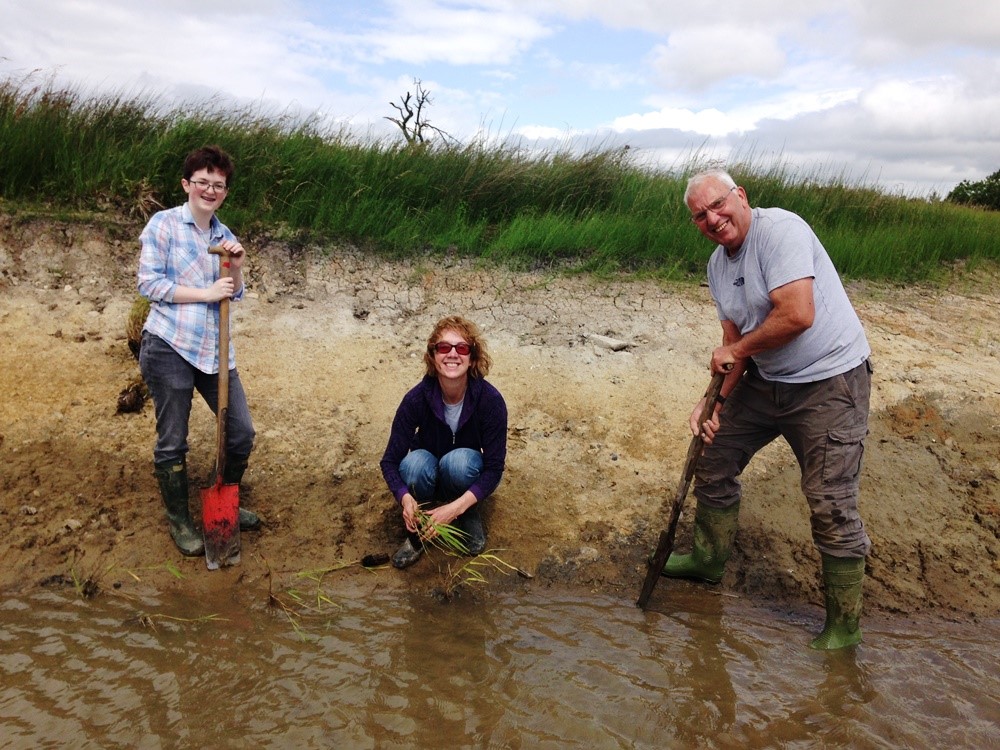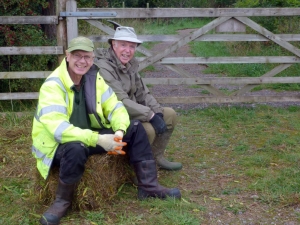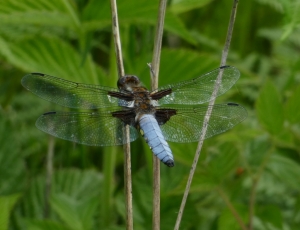Blog Archive (13) Posts Made in November 2020
Preparations
Monday, November 30th 2020
With sunshine and showers all day long the conditions were perfect for rainbows. This photograph was taken by Olivia as she checked on the sheep. It seems that there could be a pot of gold at the bottom of Spigot Mere!

It was a job worth doing as some of the Hebrideans had escaped and were in the wildflower meadow again! Luckily Gerry and Olivia have perfected their shepherding skills and they were soon rounded up back onto the wetland.
Preparations for the new Willow fence continued in the Scrapes. This is a project led by students on work placement from Askham Bryan.
Inside, more preparations were underway as the Christmas tree was decorated ready for the Field centre to be re-opened on Wednesday.
The toilets, shop area and activity room will be open again however, the kitchen will remain closed to visitors for now. All people entering the Field Centre must either sign in using the NHS App or leave their contact details on the paper log sheet. Masks must be worn and all people entering the building are requested to use the hand sanitiser provided.
There is a lot in the pipeline for the run up to Christmas. Over the next few weeks there will be a self guided Christmas trail; clue sheets will be available from the centre for only 50p each. Our popular Reindeer food will be back on sale (sprinkle it on your lawn to feed Rudolph and his gang on Christmas Eve) alongside newly designed Foxglove Christmas cards. Watch this space!
Kestrels and Sparrowhawks
Sunday, November 29th 2020
Bird ringing is a way of learning about migration but it can also teach us about longevity too. This Kestrel that was caught by some of the bird ringers last weekend was first ringed as an adult in 2012, making it at least 9 years old!
Another Kestrel was ringed during the week too. This one was a young male and hadn't been caught deliberately in a mist net but had been found laying in a field by a member of the public. Raye Wilkinson took it in and looked after it and it was brought to the reserve to be ringed. It has since been successfully released back into the wild close to where it was discovered.
The release went even better than expected with the bird flying a good distance straight away. With their huge black eyes Kestrels can spot small prey from 200 feet above the ground.
Another small bird of prey, the Sparrowhawk, is occasionally caught in the mist nets. This adult male was ringed yesterday by one of the ringers in their back garden.
As with Kestrels, the male Sparrowhawks are smaller than the females. They are more colourful too; their heads are blue-grey with reddish cheeks and the chin and upperthroat are white. Sparrowhawks’ eyes are orange surrounded by a yellow eye ring and legs and feet are yellow.
Those eyes!
Opening Up The Views
Saturday, November 28th 2020
Once the Willow Coppice is complete, the view from the scrapes will be opened up. It already looks different; a Holly and an Oak were revealed by volunteers last week and will become features when the Willow cutting is complete. All of the Willow in this area will be cut to ground level to encourage regeneration.
Further along the Red Route, Alder trees were removed from the front of the main bridge to the hide. Not only will this benefit the visitors as the view will be opened up, it will also free up the flight path of birds that use the lake such as Kingfishers and Grey Wagtails and allow more light to reach the floor for wildflowers.
Other important pruning jobs were carried out too.
Volunteers also painted fingerposts, built new Mink rafts, organised digital photographs, filled bird feeders, updated social media and monitored the observation bee hive plus much more. The roles of volunteers are very varied so if you feel that you have some time to offer and would like to learn new skills then please get in touch with the Reserve Managers who would love to hear from you!
On Thursday, two very important visitors came to Foxglove Covert LNR in their role as assessors for the Queen's Award for Voluntary Service. The Reserve has been nominated for this very prestigious award and the Management Group and Reserve Managers have worked hard behind the scenes, which resulted in us being short-listed for the Award. It is hoped that the assessors were impressed with what they found and that we fulfilled the criteria needed in order to be successful. The results will be announced in Spring 2021. Chair of the Management Group, Lesley Garbutt, wishes to thank everyone present on the day for their important contribution. Her thanks also go to each and every person involved with the Reserve who, together, make a successful team and ensure that we go from strength to strength.
A New Flock!
Wednesday, November 25th 2020
The Hebridean sheep, Thor and his flock, were rounded up last week to be taken back to Gam Farm for the winter months. The ewes are all in lamb and will be best looked after on the farm under the watchful eye of their owners. They have been easy to look after and are all in good health after spending the summer months grazing on the heathland and wetland.

Volunteers helped to move them to the edge of the wet meadows where the trailer was waiting for them. Not an easy job with so many ponds to negotiate!

It is hoped that Thor and his group will return in the spring but until then, six young Hebrideans (black) along with two Shetland sheep (brown) are on loan and will continue to carry out an important conservation role on the reserve.

Down in the heart of the reserve, work has continued on coppicing the Willow Carr and two students from Askham Bryan College have been making good use of the cut stems by creating a new Willow fence alongside a net ride.

This is a skill that has been learned on their course and one which they are keen to put into practice. The project is in the early planning stage and we look forward to seeing the end product in a few weeks time…no pressure!
More Fungi
Sunday, November 22nd 2020
Fungi and trees have a close relationship which isn't entirely understood. There are many species of fungi that are associated with Beech trees such as this Beech Tarcrust Biscogniauxia nummularia. This shiny black fungus that develops into a crust is found on dead Beech wood.
Beech Milkcap Lactarius blennius is so called because when the gills are cut or torn, a milky latex is exuded. The Latin blennius means slimy. (Another of the common names for this species is the Slimy Milkcap).
Beech Woodwart Hypoxylon fragiforme also grows on dead wood. The fruiting bodies are bright salmon pink at first becoming brick red and later blackening, with a finely warted surface. It is important to know the that this fungus was found on Beech to distinguish it from similar species such as Birch Woodwart.
White Saddle Helvella crispa grows in the leaf litter of Beech and Oak trees.
Laccaria laccata is called the Deceiver because it looks like many other small fungi and can be various hues and colours. Its habitat is mixed wood and heathland, parks and paths. At Foxglove, it too can be found below Beech trees.
This Alder Bracket Inonotus radiatus was on an Alder near Risedale Beck. It is apricot to rusty brown coloured with slightly sunken reddish droplets near the margin when young, becoming browner, and eventually almost black with age.
Wrinkled Club Clavulina rugosa is a common and widespread fungi, often found alongside woodland paths. At Foxglove look out for it in the Sitka Spruce plantation on the way to the wetland hide.
Jellybaby Leotia lubrica are also associated with conifer woodand and despite their name they are inedible!
Thank you to the team of species recording volunteers for identifying these magnificent fungi and special thanks to Chris Meek for sharing these detailed photographs.
Coppicing Continues
Wednesday, November 18th 2020
After ten years of growth, the Willow in the coppice block to be cut this year, is surprisingly tall. It is a mammoth task but a rewarding one as you can definitely see where you have been!

As with all of our woodland work, any wood that can be used elsewhere is kept to one side. Willow Carr by definition is a waterlogged woodland therefore wellies are essential!

Once cleared, the area seems bare and rather sad however, by early next year it will quickly spring back into life.

Wet Willow is not a favourite for making a bonfire, but Brian loves a challenge!

Are the potatoes ready yet?!
The Co-op, Thor and Straw!
Tuesday, November 17th 2020
Jennifer Scott, the Leyburn Co-Op Member Pioneer for the area, visited the reserve today to see how recent funds from the Co-op's Local Community Fund scheme have been used.

We are still part of this scheme and it's easy to do ... simply log on and follow the links supporting your local causes. You'll find us in the SPACES category. Just click here! So far, a staggering £4,758.11 has been raised! If you don't live locally, you can still choose Foxglove as your cause by quoting the reference number: 35823
The team have been hard at work today. The first job of the day was to check on Thor, the Hebridean Ram, who was reported to have a limp. Gerry and Ian managed to hold him still while they treated his foot. Hopefully, he will improve over the next few days.

Further along the moorland at Spigot Mere, a Bale of Barley straw was pinned into the water. This may seem like an odd thing to do however, it is to do with algae control. There are some algal blooms around the edges of the mere and although Barley straw doesn't kill algae, it inhibits any new growth.

Work also continued on the Willow coppicing, more on that tomorrow!
Let The Coppicing Commence!
Thursday, November 12th 2020
Coppicing is a traditional form of woodland management that promotes new growth and is great for wildlife. At Foxglove, it works on a ten year rotation, so that each part of the Willow Carr is coppiced once every ten years.
Using hand tools only such as pruning saws and loppers, the team soon made a good dent in the area to be cleared this winter.
The brash was processed into small manageable pieces.
There is plenty still to cut and this will be the main job on the reserve this winter.
Other invasive species such as Gorse and Silver Birch were also removed to make way for the many wildflowers that flourish here in the summer months.
If you have a use for some freshly cut Willow (around 5cm in diameter), please get in touch with the Reserve Managers on 07754 270980.
Some Good News
Tuesday, November 10th 2020
Two more rescued owls were brought to the reserve this morning to be ringed before their release back into the wild. Another Tawny owl…

...and a beautiful Barn owl.

There aren't many opportunities to see both species up close and side by side!

They will be released back into their natural habitats over the next few days when the weather is suitable. There was further good news for the Foxglove team as the final strimming task of the year was completed too. A large glade which is managed for Sedge Warblers was last on the list this year as the flowers have only just finished flowering. Here is the 'before' photograph.

It was hard work raking up the cuttings.

These were removed from the area in order to reduce the nutrients going back into the soil which will benefit the wildflowers.

The 'after' photo shows what a neat job was made.

Other work carried out included boardwalk repairs, sign painting, re-staking of trees that the Hebridean sheep had knocked over and clearing around these Juniper trees that had become engulfed in scrub!

All in all, an interesting and productive day on the reserve, thank you to all involved!
Willows, Winners and Wildlife Houses!
Sunday, November 8th 2020
The benefits of recent woodland work are clear to see with so much more light beaming through the plantation at the top of the green route. A beautiful old willow was uncovered in the middle of the conifers and has been left untouched as a feature. It looks a lot like the 'Whomping Willow' from Harry Potter!

From willows to winners and congratulations go to Mrs Lowther who is the winner of this quarter's 100 club draw. A cheque for £25 is on its way! The Foxglove Covert 100 Club is open to anyone aged over 18 and costs just £11 per year.

Finally, thank you to Bob who has been extremely productive at home and made a fantastic selection of wildlife homes to sell in aid of the reserve and a special display stand for them too. From bird boxes for Blue Tits, Great Tits, House Martins and Swallows to bat boxes and refuges for Toads and Hedgehogs there is something for all of the creatures that frequent a back garden.

COVID-19 Update
Wednesday, November 4th 2020
In line with government guidelines, from 5th November the outdoor space at the reserve remains open but the need for rigid bio-security measures and a common sense approach to the health requirements of all who visit really must be understood.
The carparks and public toilets are also open but the main area of the Field Centre (including the activity room, shop and kitchen) is closed.
Government guidelines mean that anyone using the toilets must wear a mask and check in to Foxglove Covert LNR on the NHS Track and Trace App or fill in their contact details on the sheet provided. Hand gel is provided in the entrance way.
The two metre rule still applies everywhere on the reserve.
The welfare and well-being of anyone associated with Foxglove Covert Local Nature Reserve is the absolute top priority of the Management Group and Staff. Access to the reserve and the observance of the government rules by all who visit is mandatory and must be complied with minimising the risk to all comers.
Please enjoy your visit and remember that it is your responsibility to follow the guidance on the new national restrictions.
We are very grateful to all of our supporters for helping us work through these plans, and for their continued loyal support.
Thank you for your understanding.
Larch
Wednesday, November 4th 2020
Stormy weather last weekend caused one of the old Larch trees at the top of the woodland to fall. It was close to the footpath and so although it was caught up on adjacent trees, it was a hazard and had to be removed. This is a shame as they are beautiful trees and of great value to wildlife; the seeds are eaten by squirrels and a number of birds, including Siskin and Redpoll. The caterpillars of many moths feed on the foliage, including the Case-bearer moth and Larch pug. Larch tortrix moth caterpillars eat the cone scales. They are an unusual conifer because their needles turn golden and fall off in Autumn (often they are mistaken to be dying).
Luckily, this one was not too far from where work is being carried out in the woodland. The tree was cut into manageable pieces and the brash went onto the bonfire. In European folklore, Larch was said to protect against enchantment and the wearing and burning of Larch was thought to protect against evil spirits!
Due to its high resin content, it is particularly durable in wet conditions so the tree trunk was used to edge the pathway next to where it had grown. It should last for several years.
Further along on the green route, the footpath is cloaked in fallen needles making the path inviting.
Autumn Moths
Sunday, November 1st 2020
When the weather has been calm enough, the moth trap has been set regularly. There are several species that only fly late in the year such as this Feathered Thorn which flies between mid September and early December. The males are often seen on the wing after dark and readily come to light several hours after dusk.
Green-brindled Crescent is often found at dark feeding at Ivy flowers and blackberries. There are two forms of this pretty patterned moth and both were discovered in the same trap. The dark one is a tawny brown colour.
The forewings of the paler form are 'dusted' with bright metallic green. Both forms have a white crescent-like mark on their forewings.
Another species that feeds on Ivy and blackberries is Pink-barred Sallow. The larval foodplants include the catkins of sallows where the larvae feed until the catkins fall. Once on the ground they construct an underground cocoon.
Yellow-line Quaker is on the wing from September to November and overwinters as an egg, laid on the branches of its foodplant.
A similar but slightly larger moth is Red-line Quaker. Woodland rides are one of its preferred habitats and the larval foodplants are the catkins and leaves of willows so the willow carr laced with net rides at Foxglove is perfect for this bonny moth!
Thank you to the team of species recorders for identifying the species and to Christine Meek for sharing these photographs and of course to Gerry for putting out the traps!






































